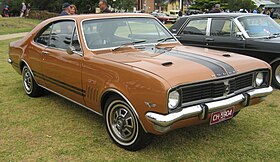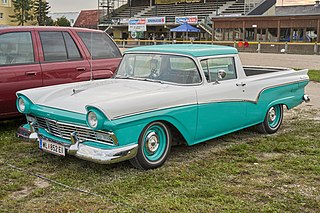
The Ford Ranchero is a coupe utility that was produced by Ford between 1957 and 1979. Unlike a standard pickup truck, the Ranchero was adapted from a two-door station wagon platform that integrated the cab and cargo bed into the body. A total of 508,355 units were produced during the model's production run. Over its lifespan it was variously derived from full-sized, compact, and intermediate automobiles sold by Ford for the North American market.
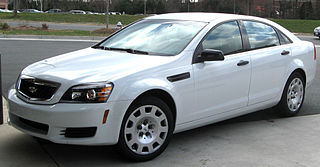
The Chevrolet Caprice is a full-size car produced by Chevrolet in North America for the 1965 to 1996 model years. Full-size Chevrolet sales peaked in 1965 with over a million sold. It was the most popular car in the U.S. in the 1960s and early 1970s, which, during its lifetime, included the Biscayne, Bel Air, and Impala.

The Opel Omega is an executive car engineered and manufactured by German automaker Opel between 1986 and 2004. The first generation, the Omega A (1986–1994), superseded the Opel Rekord. It was voted European Car of the Year for 1987, and was available as a saloon or estate. The second generation, the Omega B, was manufactured from 1994 to 2004.

The Holden Monaro is a car which was manufactured by General Motors' Australian division Holden. It has a front-engine, rear-wheel-drive layout and was produced with a two-door coupé body from 1968 to 1975 and again from 2001 to 2006 and with a 4-door sedan body from 1973 to 1977.

The Ford LTD is a range of automobiles manufactured by Ford for the 1965 to 1986 model years. Introduced as the highest trim level of the full-size Ford model range, the LTD moved the Ford range upmarket, offering options and features previously reserved for Mercury and Lincoln vehicles. For much of its production life, the LTD competed against the Chevrolet Caprice ; the Mercury Marquis served as its divisional counterpart from 1967 until 1986.

The Holden Kingswood is a full-size car that was developed and manufactured in Australia by Holden, from the beginning of the HK series in 1968 through to the conclusion of the WB series in 1985. Prior to 1968, the full-size Holden range of family cars comprised the Holden Standard, the Holden Special, and Holden Premier models. Initially, the HK range of models included the basic Holden Belmont, the Kingswood, and the luxury-oriented Holden Premier, all of which were manufactured in a choice of sedan and station wagon bodies. Commercial variants were offered in three types: coupé utility, panel van, and later from 1971, a heavy-duty Holden One Tonner cab chassis. The utility (ute) version was originally marketed in both Belmont and Kingswood configurations. However, after the Belmont name was deleted from commercials at the end of HQ in late 1974, the base model commercials were sold only with the "Holden" badge.

The Ford LTD II is an automobile produced and marketed by Ford Motor Company between 1977 and 1979 in the United States and Canada. Deriving its name from the full-sized Ford LTD model line, the intermediate LTD II consolidated the Ford Torino and Gran Torino model lines, with the Ford Elite replaced by the Ford Thunderbird. Offered in a two-door sedan, four-door sedan, and station wagon, the LTD II also served as a basis for the final generation of the Ford Ranchero coupe utility.

A panel van, also known as a blind van, car-derived van or sedan delivery, is a small cargo vehicle with a passenger car chassis, typically with a single front bench seat and no side windows behind the B-pillar. Panel vans are smaller than panel trucks or cargo vans, both of which use body-on-frame truck chassis.

The Holden Ute was a coupe utility built by Holden, the Australian subsidiary of General Motors, since 2000. Before then, Holden had marketed their Commodore-based utility models under the Holden Utility (VG) and Holden Commodore utility names, although the term “Holden Ute” was also used in their official marketing literature. The Holden Ute name is often used for earlier Holden Utility models as the word "ute" is a colloquial term used commonly in Australia for a utility vehicle. Holden's performance division, an independent company called HSV assembles a high-performance version called the Maloo. Between 2003 and 2007, Holden built a stretched, crew cab version of the Ute with four doors and seating for five, called the Holden Crewman and between 2003 and 2005 a cab-chassis version known as the Holden One Tonner.

A ute, originally an abbreviation for "utility" or "coupé utility", is a term used in Australia and New Zealand to describe vehicles with a tonneau behind the passenger compartment, that can be driven with a regular driver's licence.

The Ford Falcon (AU) is a full-size car that was produced by Ford Australia from 1998 to 2002. It was the sixth generation Ford Falcon and also included the Ford Fairmont (AU)—the luxury-oriented model range. The AU series replaced the EL Falcon and was constructed on the (at the time) new EA169 platform which continued to harbour Falcon models until 2010 when the BF wagon was discontinued, and Ford Territory models until 2011. The AU series was replaced by the updated BA series.
Full-size Ford is a term adopted for a long-running line of Ford vehicles with a shared model lineage in North America. Originating in 1908 with the Ford Model T, the line ended in 2019 with the Ford Taurus, as Ford withdrew from the full-sized sedan segment in North America. Across 111 years, 15 generations, and over 60 million examples of the model line were produced across over 50 model nameplates. By contrast, the longest-running single nameplate worldwide is the Chevrolet Suburban, in use since the 1935 model year.

Statesman is an automotive marque created in 1971 by the Australian General Motors subsidiary, Holden. Statesman vehicles were sold through Holden dealerships, and were initially based on the mainstream Holden HQ station wagon platform, thereby providing more interior room and generally more luxurious features than their Holden-branded sedan siblings. Production ceased with the last of the WB series cars in January 1985.

The Holden HQ series is a range of automobiles that was produced by Holden in Australia from 1971 to 1974. The HQ was released on 15 July 1971, replacing the Holden HG series. It was the first ground-up redesign of the Holden line since its original release in 1948, and included an all-new body, chassis, and suspension. The HQ was later developed into a series of successor models, finally ending production when the WB series was discontinued in 1985.

The Holden HK series is an automobile which was produced by Holden in Australia from 1968 to 1969. Introduced in January 1968, the HK range progressively replaced the Holden HR series which had been in production since 1966. HK models were both larger and heavier than their predecessors and the range would ultimately include thirteen different models against the eight of the HR range. The Holden HK was marketed under Belmont, Kingswood, Premier, Brougham and Monaro model names.

The Holden HJ is a series of automobiles which were produced by Holden in Australia from 1974 to 1976. The HJ series was released on 4 October 1974 and was an improved and facelifted version of the superseded Holden HQ series which had been in production since 1971.

The Holden HX is a range of automobiles which was produced by Holden in Australia from 1976 to 1977.
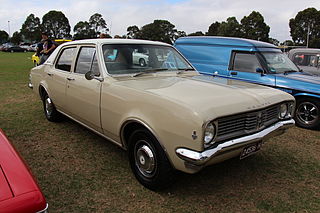
The Holden HT series is a range of automobiles which was produced by Holden in Australia between 1969 and 1970.
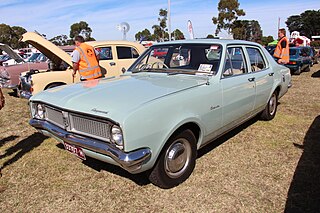
The Holden HG is an automobile which was produced by Holden in Australia between 1970 and 1971. It was marketed under Belmont, Kingswood, Premier, Brougham and Monaro model names.

A coupé utility is a vehicle with a passenger compartment at the front and an integrated cargo tray at the rear, with the front of the cargo bed doubling as the rear of the passenger compartment.




